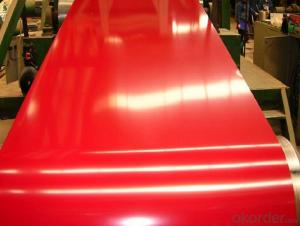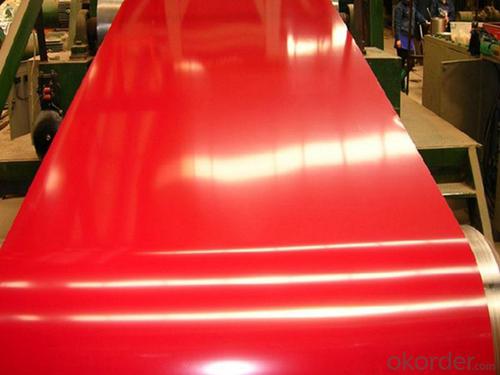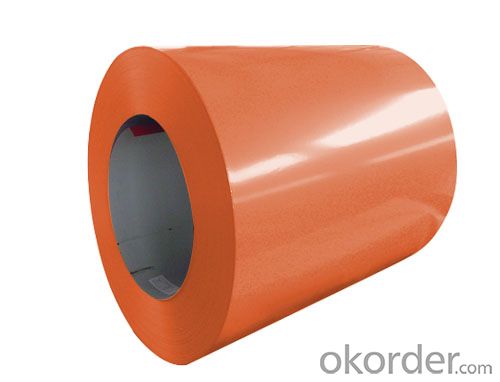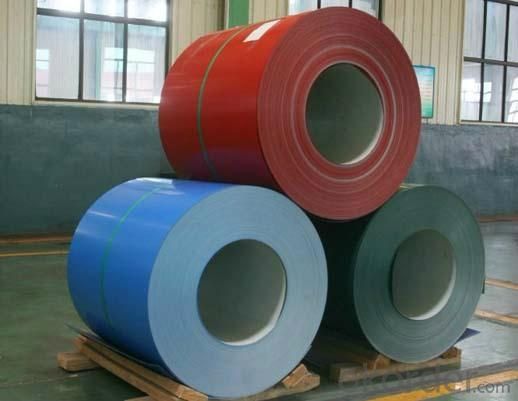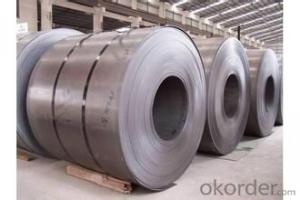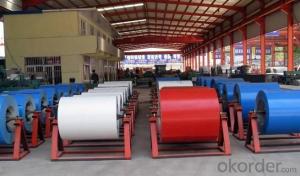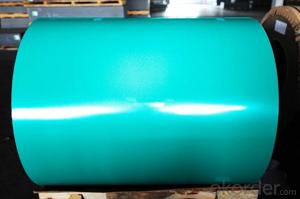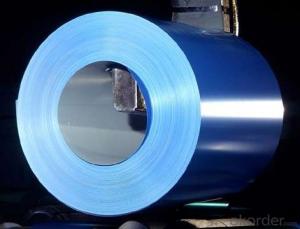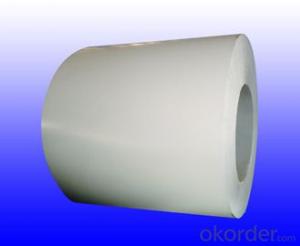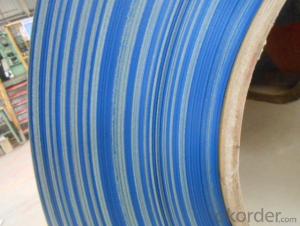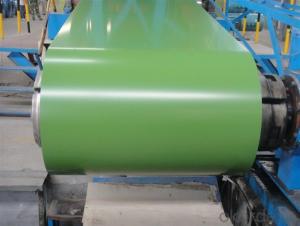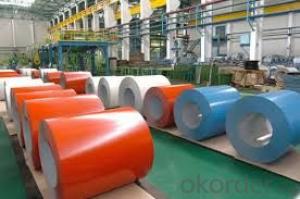Aluminized&Galvanized Color Coated sheet /PPGI with Super Quality/Color Coated coil/Zinc Plate
- Loading Port:
- Tianjin
- Payment Terms:
- TT OR LC
- Min Order Qty:
- 25 m.t.
- Supply Capability:
- 50000 m.t./month
OKorder Service Pledge
OKorder Financial Service
You Might Also Like
Galvanized Color Coated sheet Specifications
Prepaint Alu-zinc Steel Coil
.Thicknee:0.10-1.20mm
.Width:700-1250mm
.Good quality and service
.Standard seaworthy packing
Aluminized&Galvanized Color Coated Steel
. It is coated with organic layer, which provides higher anti-corrosion property and a longer lifespan than that of galvanized steel sheets.
. The base metals for Prepainted Steel Coil consist of cold rolled, galvanized steel coil.The finish coats of Prepainted Steel Coil can be classified into groups as follows: polyester(PE), silicon modified polyesters(SMP), polyvinylidene fluoride(PVDF), high-durability polyester(HDP), etc.
Pre-Painted Alu-zinc Steel Coil
Product Description
| Commodity | Galvanized Color Coated Steel Coil/Sheet | ||||||||
| Thicknees | 0.16-1.2 mm | Width | 600-1250mm | ||||||
| Zinc Coating | AZ30-AZ150g/m2 | Coil Weight(Min or Max) | 3-8 tons | ||||||
| Coil Inner Diameter | 508mm | 610mm | Coil Outer Diameter(Max) | ||||||
| Color | Ral Color | As Customers' requirement | |||||||
| Surface Finish | Normal Coated | Embossed | Printed | ||||||
| Category Of Finish Coating | High-durability Polyester | Silicon Modified Polyesters | |||||||
| Polyvinylidene Fluoride | Polyester | ||||||||
| Anti-static | Easy-Cleaning | ||||||||
| Coating Type | Top Surface | Bottom Surface | |||||||
| Double Coated | Double Coated | ||||||||
| Double Coated | Single Coated | ||||||||
| Coating Thickness | Top Surface: | Back Surface: | |||||||
| Coating Structure | Primer | Finish Coating | |||||||
| Epoxy Primer | Polyester | ||||||||
| Polyester Primer | Silicon Modified Polyesters | ||||||||
| Water-soluble Acrylic Acid Primer | High-durability Polyester | ||||||||
| Polyurethane Primer | Polyvinylidene Fluoride | ||||||||
| Futher Process | Cut coil into Sheet | Corrugated Roofing Sheet | |||||||
Applications
construction | workshop, agricultural warehouse, residential precast unit, corrugated roof, wall, rainwater drainage pipe, terrace, retailer booth, roller shutter door |
door, doorcase, light steel roof structure, folding screen, ceiling, elevator, stairway, vent gutter | |
Electrical appliance | refrigerator, washer, switch cabinet, instrument cabinet, air conditioning, micro-wave oven, bread maker |
Furniture | central heating slice, lampshade, chifforobe, desk, bed, locker, bookshelf |
Carrying trade | exterior decoration of auto and train, clapboard, container, isolation lairage, isolation board |
- Q: - I'm considering doing my physics coursework on the uses of Mild Steel in skyscrapers and construction, would this be right? Some sources tell me mild steel is too weak, others say it is fine
- Mild steel doesn't really mean anything, technically. In today's world all steel is mild steel unless it's high carbon or alloy, which are mostly tool steels. You'll need to study steel much deeper than that to accomplish any real physics work relating to steel.
- Q: How are steel coils formed into specific shapes?
- Steel coils are formed into specific shapes through a process called roll forming, which involves passing the coils through a series of rollers. The rollers gradually shape the steel into the desired profile, applying pressure and bending it to the required angles. This allows manufacturers to create various shapes and sizes of steel coils for different applications.
- Q: What are the quality standards for steel coil manufacturing?
- The quality standards for steel coil manufacturing typically include criteria such as dimensional accuracy, surface finish, mechanical properties, chemical composition, and adherence to industry-specific standards like ASTM or EN. These standards ensure that the steel coils meet the required specifications for various applications and provide reliable performance in terms of strength, durability, and consistency. Additionally, manufacturers often follow strict quality control processes throughout the production cycle to ensure the quality of the final product.
- Q: I have heartgold and I don't have a steel type Pokemon to beat lapras. HELP
- magneton. steel and electric type
- Q: I have to explain some functions of stainless steel but after days of searching I cant find an answer. Thankyou in advance for your help :)
- www.okorder
- Q: So today I was bored and was reading a shotgun shell box,the box was slug 12ga.I noticed it said not to be used in Damascus steel or twist barrel.It was to my understanding that Damascus steel is very strong and many stories came from what it could cut when used in a blade or sword.The little bit of info that i could find was that Damascus used earlier in the turn of the century on shotguns should not be fired unless special maintenance has been given and check out by gunsmith.So is Damascus not strong like i thought and not be able to handle higher pressure or why the reason for the warning?*
- Damascus steel is is great for blades, but does not have the strength to stand up to smokeless powder pressures.
- Q: The length of a steel beam increases by 0.78 mm when its temperature is raised from 22 degrees C to 35 degrees C. What is the length of the beam at 22 degrees C (in meters)?I used: L = (0.78 mm)/[(9/5)(.00000645 F)(13)] = 5.17 meters but Mastering Physics said Not quite. Check through your calculations; you may have made a rounding error or used the wrong number of significant figures. I'm confused because this is how we learned this kind of problem in class, so if anybody knows what I did wrong, feel free to correct my errors! Thanks
- ? got me is that the whole problem or is there more?
- Q: What are the different types of steel coil surface protection methods?
- There are several types of steel coil surface protection methods, including oiling, painting, galvanizing, and applying protective films. These methods help prevent corrosion, rusting, and damage to the steel surface during storage, transportation, and processing.
- Q: What are the different methods of coil edge trimming?
- There are several methods of coil edge trimming that are commonly used in various industries. These methods include: 1. Shearing: This method involves using a shear blade to cut the edges of the coil. Shearing is a common method used for cutting thick coils and can be done manually or with the help of a machine. It provides a clean and straight cut but may not be suitable for thin or delicate materials. 2. Slitting: Slitting is a process in which the coil is passed through slitter knives that make multiple cuts along the edge to create narrower strips. This method is commonly used for producing narrow coils or strips of various widths. Slitting can be done in-line with a coil processing line or as a separate standalone process. 3. Laser cutting: Laser cutting is a precise method of coil edge trimming that uses a high-powered laser beam to cut through the material. It offers high accuracy and flexibility to cut complex shapes or patterns. Laser cutting is commonly used for thin or delicate materials, as it minimizes the risk of deformation or damage caused by other cutting methods. 4. Plasma cutting: Plasma cutting is a thermal cutting process that uses a plasma torch to cut through the coil. It is suitable for cutting a wide range of materials, including thick coils. Plasma cutting is known for its high cutting speed and ability to cut through materials with high melting points, such as stainless steel or aluminum. 5. Waterjet cutting: Waterjet cutting is a method that uses a high-pressure jet of water mixed with an abrasive material to cut through the coil. It is a versatile method that can cut a wide range of materials and thicknesses. Waterjet cutting provides a smooth and precise cut without heat-affected zones, making it suitable for sensitive materials. 6. Guillotine cutting: Guillotine cutting involves using a guillotine-style blade to cut through the coil. It is a quick and efficient method that provides a straight cut. Guillotine cutting is commonly used for cutting coils of various thicknesses and is often performed with the help of a machine for higher precision. Each method of coil edge trimming has its own advantages and considerations depending on the specific requirements of the application. The choice of method usually depends on factors such as material properties, thickness, desired cutting accuracy, production volume, and budget constraints.
- Q: What are the disadvantages of using steel coils?
- One disadvantage of using steel coils is their high weight and bulkiness, which can make transportation and handling more difficult and costly. Additionally, steel coils are prone to rust and corrosion, requiring proper maintenance and protective coatings to prevent deterioration. Lastly, steel coils can be expensive to produce and purchase, making them less cost-effective compared to alternative materials in certain applications.
Send your message to us
Aluminized&Galvanized Color Coated sheet /PPGI with Super Quality/Color Coated coil/Zinc Plate
- Loading Port:
- Tianjin
- Payment Terms:
- TT OR LC
- Min Order Qty:
- 25 m.t.
- Supply Capability:
- 50000 m.t./month
OKorder Service Pledge
OKorder Financial Service
Similar products
Hot products
Hot Searches
Related keywords
